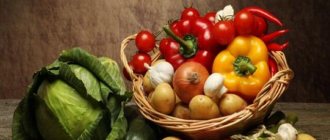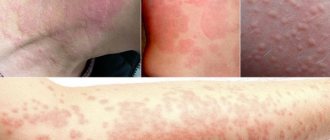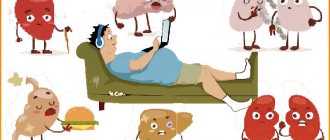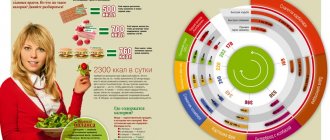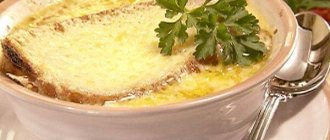In 1992, in the United States, cardiologists at the National Heart, Lung, and Blood Institute (NHLBI) developed a nutritional system for treating high blood pressure without drugs. It is known as “Dietary Approaches to Stop Hypertension” (a long phrase turned into a short acronym - that’s why the diet is called dash), which translates from English as “dietary approach to stopping hypertension.” Not long ago, it topped the ranking of the best methods for weight loss and since then has been actively used not only for therapeutic purposes, but also for weight loss.
General rules
Non-drug methods of treating arterial hypertension are the most important component of complex therapy, making it possible to influence negative risk factors that contribute to increased blood pressure.
Long-term and pronounced exposure to such factors reduces the adaptive capabilities of the body in general and the cardiovascular system in particular, which leads to persistent chronic increases in blood pressure ( hypertension ). It has been established that properly organized nutrition with high blood pressure is a factor not only in stabilizing it, but also in lowering it to the age norm.
One of these types of diets is the dash diet, the acronym of which stands for Dietary Approaches to Stop Hypertension, which translates as “a dietary approach to preventing hypertension.” Unlike many other diets, the recommended diet of the “DASH” system (a diet reduced in total fat, sodium, saturated fat, cholesterol and the inclusion of fruits, vegetables, low-fat dairy products and enriched with calcium, magnesium, potassium) is based on reliably confirmed results of clinical studies of volunteers, which indicate that systolic pressure during a two-week diet decreased on average by 11 mm, and diastolic pressure by 6 mm Hg. Art.
These results suggest that the dash diet may be an effective alternative to drug therapy, especially for patients with stage 1 hypertension, and may eliminate/delay the onset of switching to antihypertensive medications.
The main principles of the DASH diet are:
- Limiting the total salt intake to 5-6 g/day and 2-3 g per day in a more strict version of the diet, which is achieved by eliminating salt during the cooking process (only ready-made dishes can be lightly added) and excluding foods containing salt from the diet ( smoked meats, fast food, pickles and marinades, canned food, sausages).
- Replacing wheat bread with grain and wholemeal bread, and pasta with brown rice.
- Consuming exclusively dietary meat or fish in small quantities (150-200 g/day).
- The mandatory presence of cereal products and sprouted grains in the diet.
- Increasing the amount of vegetables and fruits to 500-600 g/day.
- Replacing animal fats/trans fats with vegetable (linseed, olive, sunflower) oils. The optimal rate is 2 tablespoons/day.
- Inclusion of low-fat/low-fat dairy and fermented milk products in the diet.
- Inclusion in the diet of legumes and seeds (stewed beans, boiled peas, soy and lentil dishes, pumpkin seeds, sunflower seeds, sesame seeds) in the amount of 350 - 400 g/week.
- Limiting foods containing simple carbohydrates (almost all sweets, sugar) to 75 g per week.
The daily diet includes the following products: bread and cereal products (4 cups of cereals, rice, pasta), meat/fish products (150-200 g of meat or 250 g of fish), vegetables (500-600 g), fruits (250 -300 g), low-fat/low-fat dairy products (500-700 ml yogurt/kefir, or 400 g low-fat cottage cheese), vegetable fats (3 tablespoons), legumes, nuts, seeds (3 glasses per week), sweets (150- 200 g per week).
There are several diet options, but on average, the energy value of the diet is about 2000 Kcal/day, which allows patients to lose excess body weight.
It should be noted that the DAS diet for weight loss, as such, is not intended; rather, we can talk about weight loss as a beneficial side effect for patients, since the antihypertensive effect of weight loss in patients with hypertension and increased body weight has been reliably proven and there is a direct correlation between weight loss in such patients and a decrease in blood pressure in the proportion of 1 kg/1 mm Hg. Art.
Additional beneficial effects of this diet include a decrease in total cholesterol and, especially, low-density lipoproteins (LDL), which is due to the limitation of dietary cholesterol and saturated fat.
Mandatory conditions for achieving the effect of dietary nutrition are: feasible daily physical activity, cessation of smoking and alcohol abuse.
Carefully! Salt-free menu!
Even if you think you have a high salt sensitivity, it is important to remember that extremely low NaCl intake can be hazardous to your health.
A complete refusal of salt leads to heart disease, edema and increased (or onset) insulin resistance.
In fact, many people, especially those who often purchase prepared foods, introduce huge amounts of salt into their bodies - up to 12 grams.
Therefore, if they simply switch to a normal salt regime, without strict restrictions, which are usually 5-6 grams per day, their well-being improves.
Therefore, the minimum salt intake on the DASH diet is 1,500 mg. But by no means less. And no particularly strict salt regime is required. It is enough to simply completely avoid products made by the food industry. Cook on your own. Of course, using salt.
Authorized Products
The dash diet includes:
- Dietary red meat in boiled/baked form, as well as chicken, turkey, rabbit. Culinary processing of meat involves pre-boiling it, draining the broth and further cooking it in a new portion of water.
- Wheat/rye whole grain bread or with added bran, dry biscuits.
- Soups in vegetable broth with well-cooked cereals/vegetables with the addition of garden herbs.
- Sea/river fish, seafood, seaweed, fish oil.
- Vegetables (potatoes, cabbage, carrots, beets, zucchini, pumpkin, eggplants), both fresh and cooked (baked, boiled, stewed) or in the form of vinaigrettes, vegetable stews, seasoned with olive/linseed oil.
- Various types of cereal products (barley, millet, buckwheat), mainly whole grains and pasta made from durum flour in the form of a casserole with vegetables/cottage cheese.
- Low-fat/low-fat fermented milk products, milk/tomato sauces with vegetable broth, sour cream/cream sauces (only in dishes), chicken eggs up to 3 sh. per week, soft-boiled.
- Cold pressed vegetable oils (olive, flaxseed, sunflower, corn).
- Fruits/berries in any form (fresh, in compotes, jelly, jelly).
- Drinks - weak tea with milk, drinks (coffee substitutes), rosehip infusion, still mineral water, vegetable/berry juices, herbal teas.
Table of permitted products
| Proteins, g | Fats, g | Carbohydrates, g | Calories, kcal | |
Vegetables and greens | ||||
| greenery | 2,6 | 0,4 | 5,2 | 36 |
| eggplant | 1,2 | 0,1 | 4,5 | 24 |
| zucchini | 0,6 | 0,3 | 4,6 | 24 |
| cabbage | 1,8 | 0,1 | 4,7 | 27 |
| broccoli | 3,0 | 0,4 | 5,2 | 28 |
| boiled cauliflower | 1,8 | 0,3 | 4,0 | 29 |
| bulb onions | 1,4 | 0,0 | 10,4 | 41 |
| carrot | 1,3 | 0,1 | 6,9 | 32 |
| cucumbers | 0,8 | 0,1 | 2,8 | 15 |
| salad pepper | 1,3 | 0,0 | 5,3 | 27 |
| salad | 1,2 | 0,3 | 1,3 | 12 |
| beet | 1,5 | 0,1 | 8,8 | 40 |
| celery | 0,9 | 0,1 | 2,1 | 12 |
| asparagus | 1,9 | 0,1 | 3,1 | 20 |
| tomatoes | 0,6 | 0,2 | 4,2 | 20 |
| Jerusalem artichoke | 2,1 | 0,1 | 12,8 | 61 |
| pumpkin | 1,3 | 0,3 | 7,7 | 28 |
| lentils | 24,0 | 1,5 | 42,7 | 284 |
Fruits | ||||
| avocado | 2,0 | 20,0 | 7,4 | 208 |
| oranges | 0,9 | 0,2 | 8,1 | 36 |
| pomegranate | 0,9 | 0,0 | 13,9 | 52 |
| grapefruit | 0,7 | 0,2 | 6,5 | 29 |
| pears | 0,4 | 0,3 | 10,9 | 42 |
| kiwi | 1,0 | 0,6 | 10,3 | 48 |
| lemons | 0,9 | 0,1 | 3,0 | 16 |
| mango | 0,5 | 0,3 | 11,5 | 67 |
| tangerines | 0,8 | 0,2 | 7,5 | 33 |
| nectarine | 0,9 | 0,2 | 11,8 | 48 |
| peaches | 0,9 | 0,1 | 11,3 | 46 |
| apples | 0,4 | 0,4 | 9,8 | 47 |
Berries | ||||
| gooseberry | 0,7 | 0,2 | 12,0 | 43 |
| Red currants | 0,6 | 0,2 | 7,7 | 43 |
| black currant | 1,0 | 0,4 | 7,3 | 44 |
Nuts and dried fruits | ||||
| nuts | 15,0 | 40,0 | 20,0 | 500 |
| cashew | 25,7 | 54,1 | 13,2 | 643 |
| sesame | 19,4 | 48,7 | 12,2 | 565 |
| flax seeds | 18,3 | 42,2 | 28,9 | 534 |
| fenugreek seeds | 23,0 | 6,4 | 58,3 | 323 |
| sunflower seeds | 20,7 | 52,9 | 3,4 | 578 |
Cereals and porridges | ||||
| buckwheat (kernel) | 12,6 | 3,3 | 62,1 | 313 |
| oat groats | 12,3 | 6,1 | 59,5 | 342 |
| cereals | 11,9 | 7,2 | 69,3 | 366 |
| millet cereal | 11,5 | 3,3 | 69,3 | 348 |
| barley grits | 10,4 | 1,3 | 66,3 | 324 |
Bakery products | ||||
| Rye bread | 6,6 | 1,2 | 34,2 | 165 |
Raw materials and seasonings | ||||
| honey | 0,8 | 0,0 | 81,5 | 329 |
Dairy | ||||
| skim milk | 2,0 | 0,1 | 4,8 | 31 |
| natural yogurt 2% | 4,3 | 2,0 | 6,2 | 60 |
Cheeses and cottage cheese | ||||
| cottage cheese 0.6% (low fat) | 18,0 | 0,6 | 1,8 | 88 |
| curd tofu | 8,1 | 4,2 | 0,6 | 73 |
Meat products | ||||
| beef | 18,9 | 19,4 | 0,0 | 187 |
| rabbit | 21,0 | 8,0 | 0,0 | 156 |
Sausages | ||||
| boiled diet sausage | 12,1 | 13,5 | 0,0 | 170 |
Bird | ||||
| chicken fillet | 23,1 | 1,2 | 0,0 | 110 |
| turkey | 19,2 | 0,7 | 0,0 | 84 |
Fish and seafood | ||||
| fish | 18,5 | 4,9 | 0,0 | 136 |
| squid | 21,2 | 2,8 | 2,0 | 122 |
| mussels | 9,1 | 1,5 | 0,0 | 50 |
| seaweed | 0,8 | 5,1 | 0,0 | 49 |
Oils and fats | ||||
| linseed oil | 0,0 | 99,8 | 0,0 | 898 |
| olive oil | 0,0 | 99,8 | 0,0 | 898 |
| sunflower oil | 0,0 | 99,9 | 0,0 | 899 |
Non-alcoholic drinks | ||||
| mineral water | 0,0 | 0,0 | 0,0 | — |
| green tea | 0,0 | 0,0 | 0,0 | — |
| * data is per 100 g of product | ||||
Where to start - tips for beginners
A few days before starting the Dash diet, it is advisable to keep a notebook in which to write down everything that was eaten for breakfast, lunch, dinner, and also in between meals. By analyzing the records, it is easier to make adjustments to the menu, gradually replacing your favorite dishes until they fully comply with the principles of the blood pressure diet. As you can see, you don’t have to suddenly start changing your habits and life. Here are some examples of tips that will help you change your diet:
- There are few vegetables in the diet, add one serving for dinner or lunch;
- no fruits, add them to your snack between lunch and dinner;
- When reading the composition of products, choose those that do not contain preservatives, dyes or flavors;
- gradually introduce dairy products with a low fat content - kefir;
- replace instant cereals with whole grains;
- in winter, use frozen vegetables, fruits, berries;
- add nuts, seeds and legumes to your menu.
And also read on our website: How do blueberries affect a person’s blood pressure - does it increase or decrease it?
However, this is not all the recommendations. When switching to the Dash diet for hypertension, you should simultaneously begin to reduce the caloric content of food, for this:
- eat more fruits instead of the usual sweets. This will save 200 kcal;
- use vegetables as a side dish - 50 kcal;
- low-fat or low-fat foods will reduce calorie content by 70 kcal.
You can reduce calorie content by changing portion sizes, using smaller plates and drinking up to 1.5 liters of water throughout the day.
Fully or partially limited products
The dash diet includes the following exceptions:
- Rich broths from meat/fish and first courses based on them.
- Fresh wheat bread, butter/puff pastry, pastries.
- Fatty meat, culinary/animal fats, poultry meat (duck, goose), sausages, smoked meats, offal.
- Salted/smoked fish, fish caviar, canned fish/meat, mushroom sauces, cream, sour cream, fatty cheese/cottage cheese.
- Confectionery with cream, ice cream, cocoa, chocolate, black coffee and strong tea, preserves, jam.
- The consumption of salt, sugar, pickles, marinades, grapes, carbonated sodium mineral waters, and alcoholic beverages is limited.
Table of prohibited products
| Proteins, g | Fats, g | Carbohydrates, g | Calories, kcal | |
Vegetables and greens | ||||
| vegetables legumes | 9,1 | 1,6 | 27,0 | 168 |
| canned vegetables | 1,5 | 0,2 | 5,5 | 30 |
| sauerkraut | 1,8 | 0,1 | 4,4 | 19 |
| pickles | 0,8 | 0,1 | 1,7 | 11 |
| radish | 1,2 | 0,1 | 3,4 | 19 |
| white radish | 1,4 | 0,0 | 4,1 | 21 |
| red radish | 1,2 | 0,1 | 3,4 | 20 |
| black radish | 1,9 | 0,2 | 6,7 | 35 |
| spinach | 2,9 | 0,3 | 2,0 | 22 |
| sorrel | 1,5 | 0,3 | 2,9 | 19 |
Fruits | ||||
| bananas | 1,5 | 0,2 | 21,8 | 95 |
Berries | ||||
| grape | 0,6 | 0,2 | 16,8 | 65 |
Mushrooms | ||||
| mushrooms | 3,5 | 2,0 | 2,5 | 30 |
Nuts and dried fruits | ||||
| raisin | 2,9 | 0,6 | 66,0 | 264 |
Confectionery | ||||
| candies | 4,3 | 19,8 | 67,5 | 453 |
| pastry cream | 0,2 | 26,0 | 16,5 | 300 |
| shortbread dough | 6,5 | 21,6 | 49,9 | 403 |
Ice cream | ||||
| ice cream | 3,7 | 6,9 | 22,1 | 189 |
Cakes | ||||
| cake | 4,4 | 23,4 | 45,2 | 407 |
Chocolate | ||||
| chocolate | 5,4 | 35,3 | 56,5 | 544 |
Raw materials and seasonings | ||||
| mustard | 5,7 | 6,4 | 22,0 | 162 |
| mayonnaise | 2,4 | 67,0 | 3,9 | 627 |
Dairy | ||||
| milk 3.6% | 2,8 | 3,6 | 4,7 | 62 |
| milk 4.5% | 3,1 | 4,5 | 4,7 | 72 |
| cream | 2,8 | 20,0 | 3,7 | 205 |
| sour cream 25% (classic) | 2,6 | 25,0 | 2,5 | 248 |
Cheeses and cottage cheese | ||||
| cheese | 24,1 | 29,5 | 0,3 | 363 |
| cottage cheese 18% (fat) | 14,0 | 18,0 | 2,8 | 232 |
Meat products | ||||
| pork | 16,0 | 21,6 | 0,0 | 259 |
| pork liver | 18,8 | 3,6 | 0,0 | 108 |
| pork kidneys | 13,0 | 3,1 | 0,0 | 80 |
| pork fat | 1,4 | 92,8 | 0,0 | 841 |
| salo | 2,4 | 89,0 | 0,0 | 797 |
| beef liver | 17,4 | 3,1 | 0,0 | 98 |
| beef kidneys | 12,5 | 1,8 | 0,0 | 66 |
| beef brains | 9,5 | 9,5 | 0,0 | 124 |
Sausages | ||||
| smoked sausage | 16,2 | 44,6 | 0,0 | 466 |
| smoked sausage | 9,9 | 63,2 | 0,3 | 608 |
| sausages | 10,1 | 31,6 | 1,9 | 332 |
| sausages | 12,3 | 25,3 | 0,0 | 277 |
Bird | ||||
| smoked chicken | 27,5 | 8,2 | 0,0 | 184 |
| duck | 16,5 | 61,2 | 0,0 | 346 |
| smoked duck | 19,0 | 28,4 | 0,0 | 337 |
| goose | 16,1 | 33,3 | 0,0 | 364 |
Fish and seafood | ||||
| smoked fish | 26,8 | 9,9 | 0,0 | 196 |
| salted fish | 19,2 | 2,0 | 0,0 | 190 |
| Red caviar | 32,0 | 15,0 | 0,0 | 263 |
| black caviar | 28,0 | 9,7 | 0,0 | 203 |
| canned fish | 17,5 | 2,0 | 0,0 | 88 |
| cod (liver in oil) | 4,2 | 65,7 | 1,2 | 613 |
Oils and fats | ||||
| animal fat | 0,0 | 99,7 | 0,0 | 897 |
| cooking fat | 0,0 | 99,7 | 0,0 | 897 |
Non-alcoholic drinks | ||||
| instant coffee dry | 15,0 | 3,5 | 0,0 | 94 |
| black tea | 20,0 | 5,1 | 6,9 | 152 |
| * data is per 100 g of product | ||||
Basic rules of the dash diet
Below, dear readers, you will find a list of the rules of the dasha system:
- a taboo is placed on baked goods, store-bought sweets, everything smoked, fries, highly salted, as well as fast food;
- salt consumption should be reduced to 1/3 teaspoon per day;
- the main products in the diet are vegetables, a variety of cereals, fruits, fish, berries, any lean meat, exclusively whole grain bread, low-fat milk, legumes;
- alcohol and smoking are also taboos;
- There is a minimum of animal fats; they are replaced with vegetable oils.
DASH Diet Menu (Diet Mode)
The DASH diet menu is compiled according to the permitted products listed above. Below is a tentative menu for the week:
Monday
| Breakfast |
|
| Dinner |
|
| Dinner |
|
Tuesday
| Breakfast |
|
| Dinner |
|
| Dinner |
|
Wednesday
| Breakfast |
|
| Dinner |
|
| Dinner |
|
Thursday
| Breakfast |
|
| Lunch |
|
| Dinner |
|
| Dinner |
|
Friday
| Breakfast |
|
| Dinner |
|
| Dinner |
|
Saturday
| Breakfast |
|
| Dinner |
|
| Dinner |
|
Sunday
| Breakfast |
|
| Dinner |
|
| Dinner |
|
When you feel hungry, you are allowed to snack on fruit.
FAQ
If you're thinking about trying DASH to lower your blood pressure, you may have a few questions about other aspects of your lifestyle.
Below are answers to the most frequently asked questions.
Can you drink coffee on the DASH diet?
The DASH diet does not provide specific recommendations for coffee consumption. However, some people are concerned that caffeinated drinks such as coffee may raise their blood pressure.
It is well known that caffeine can cause a short-term increase in blood pressure ().
Additionally, this increase is greatest in people with high blood pressure (,).
However, a recent review stated that this popular drink does not increase the long-term risk of high blood pressure or cardiovascular disease, even though it causes a short-term (1-3 hour) increase in blood pressure ().
For most healthy people with normal blood pressure, 3-4 regular cups of coffee per day is considered safe ().
Keep in mind that the slight increase in blood pressure (5–10 mmHg) caused by caffeine means that people who already have high blood pressure should probably be more careful with their coffee consumption.
Do I need to exercise on the DASH diet?
The DASH diet is even more effective in lowering blood pressure when combined with physical activity ().
Given the independent health benefits of exercise, this is not surprising.
It's recommended to do 30 minutes of moderate exercise most days, and it's important to choose something you enjoy so you're more likely to stick with it.
Here are examples of moderate physical activity:
- Brisk walking (a kilometer in 9 minutes)
- Running (a kilometer in 6 minutes)
- Cycling (a kilometer in 4 minutes)
- Swimming (20 minutes)
- Housework (60 minutes)
Can you drink alcohol on the DASH diet?
Excessive alcohol consumption can increase blood pressure ().
In fact, regularly drinking more than three drinks a day is associated with an increased risk of high blood pressure and cardiovascular disease ().
On the DASH diet, you should drink alcohol in moderation and not exceed the official recommendations of 2 or fewer drinks per day for men and 1 or less for women.
*1 “drink” (alcoholic drink) = 1 glass of 40% vodka or cognac (40 ml), 1 glass of 12% wine (150 ml), 1 glass of 7% malt liquor (230 ml) or 1 small glass of 5% beer ( 350 ml).
Summary:
You can drink moderate amounts of coffee and alcohol on the DASH diet. Combining the DASH diet with exercise can make it even more effective.
Reviews and results
Nutrition according to the DASH diet, according to patient reviews, especially in the initial stages of hypertension, is an effective treatment method that helps normalize increased body weight, blood pressure and cholesterol levels.
The diet, in general, is well tolerated, but some patients suffer from low-salt foods, lack of smoked foods, and limiting sweets and sugar.
- “... The Dash diet was recommended to me by my friend in misfortune - a hypertensive patient with ten years of experience. I studied the literature about this diet on an English-language website, it’s good that I speak English at the required level. Oddly enough, I didn’t discover anything new for myself. Almost the same as the diet of treatment Table No. 10 for hypertensive patients, which I have been on for almost a year. The main thing is to limit salt, everything salty and smoked, meat and sweets. Rather, this is a tribute to fashion, so I did not change anything in my diet, which my local doctor described in detail to me. Almost a year has passed, the pressure has been stabilized, I have lost weight, and my overall health has improved”;
- “... I read about the Dash diet on a specialized forum for hypertensive patients. I decided to try it because my blood pressure has been unstable lately and is often elevated after stress. For a long time I couldn’t eat lightly salted food, I got used to sausages, salted fish, and ham. And I often indulged myself in sweets. But over time, I learned to flavor food with mild herbal spices, garden herbs, garlic/onions, and dried fruits. After six months, my weight returned to normal, shortness of breath disappeared, and my blood pressure leveled out. I practice walking and cycling.”
Severely limiting your salt intake is bad for your health
Eating too little salt is associated with health problems such as an increased risk of heart disease, insulin resistance and fluid retention.
The low-salt version of the DASH diet recommends that people consume no more than 3/4 teaspoon (1,500 mg) of sodium per day.
However, it is unclear whether there is any benefit from reducing salt intake to such low levels - even for people with high blood pressure ().
In fact, a recent review found no link between salt intake and the risk of death from heart disease, although lowering salt intake resulted in a modest reduction in blood pressure ().
However, since most people eat too much salt, reducing salt intake from a very high amount of 2–2.5 teaspoons (10–12 grams) per day to 1–1.25 teaspoons (5–6 grams) per day may be beneficial useful().
This goal can be easily achieved by reducing the amount of highly processed foods in your diet and eating mostly whole foods.
Summary:
While reducing salt intake from processed foods is beneficial for most people, eating too little salt can also be harmful.
Summarize
- The DASH diet can be a simple and effective way to lower your blood pressure.
- However, keep in mind that reducing your daily salt intake to 3/4 teaspoon (1,500 mg) or less has not been associated with any major health benefits, such as a reduced risk of heart disease, although it may reduce blood pressure.
- Moreover, the DASH diet is very similar to a standard low-fat diet, which large controlled studies have shown does not reduce the risk of death from heart disease (, ).
- Healthy people may have little reason to follow this diet. However, if you have high blood pressure or think you are salt sensitive, DASH may be a good choice for you.
The article was prepared by experts for informational purposes only. It should not be used as a guide for treating medical conditions and is not a substitute for professional medical advice, diagnosis, or treatment. In case of illness or any symptoms, you should always consult a doctor and not self-medicate.
Tags: High Blood Pressure, DASH Diet
About the author: Anastasia Sheveleva
Candidate of Medical Sciences, doctor of the highest category, therapist, registered dietitian, nutrition consultant. More about the author.
- Related Posts
- Can vegetarians eat fish or seafood?
- 6 Best Diets for Heart Health
- What is a low-carbohydrate diet and what foods can you eat?
« Previous entry

